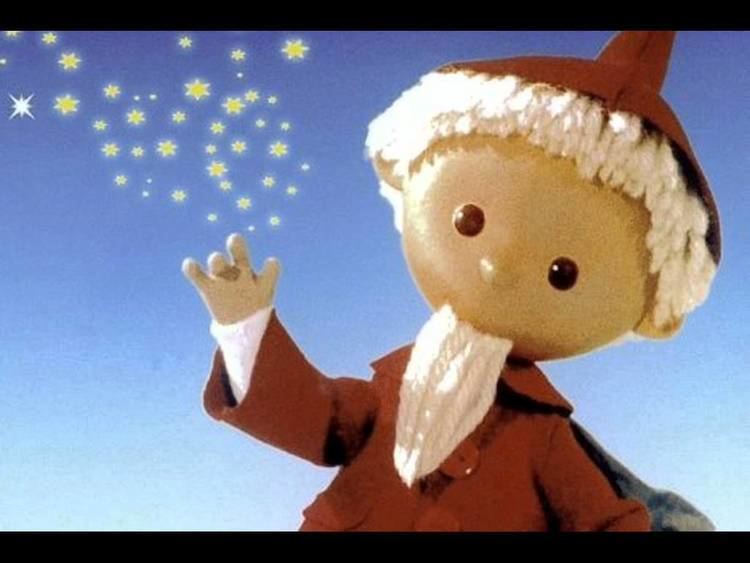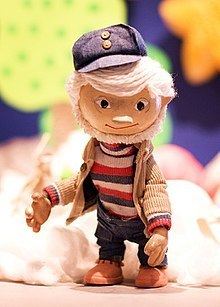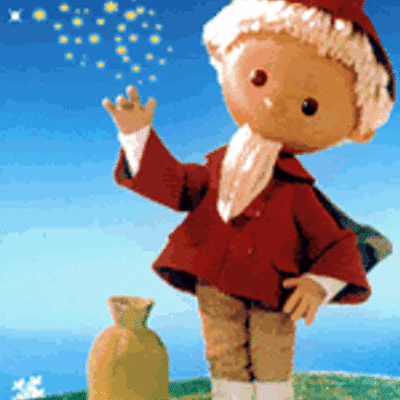5 /10 2 Votes
First episode date 1959 | 7.9/10 IMDb | |||||||||||||||||||||||||||||||||
Characters Drehrumbum, Borstel, Annemarie, Bimbo, Bärchen Genres Animation, Family film, Children's television series, Comedy, Fantasy, Musical Cast Heinz Schröder, Bärbel Ola‑Möllendorf, Sergey Obraztsov, Peter Bosse, Barbara Augustin Similar Die Sendung mit der M, Tanzalarm, Löwenzahn, Schloss Einstein, Wissen Macht Ah! Profiles | ||||||||||||||||||||||||||||||||||
Sandm nnchen
Unser Sandmännchen, Das Sandmännchen, Abendgruß, Sandmann, Sandmännchen (Little Sandman) is a German children's bedtime television programme using stop motion animation. The puppet was based on the Ole Lukøje character by Hans Christian Andersen.
Contents
- Sandm nnchen
- Background
- Theme tune
- International broadcasts
- Supporting characters
- In popular culture
- References

Background
Two versions of Sandmännchen were created: one in East Germany (Unser Sandmännchen), and one in West Germany (Das Sandmännchen).

The original idea came from Ilse Obrig of West Berlin TV and radio station Sender Freies Berlin (SFB), who with the help of author Johanna Schüppel, developed a working version in 1958. The Little Sandman himself first appeared on screen in West Berlin in Sandmännchens Gruß für Kinder (Sandmännchen's Greeting to Children) on 1 December 1959, and other episodes were soon made.

However, on 22 November 1959 (only three weeks after the production had started), East German television (Deutscher Fernsehfunk, DFF) began broadcasting its own Unser Sandmännchen, complete with its own "good night, children" character, also called Sandmännchen.

Created by the puppetmaster and director Gerhard Behrendt, the East German show represented everyday life, travel, and fantastic adventures. The character often showcased socialist technological achievements, such as the use of awe-inspiring vehicles like futuristic cars and flying devices. It was very popular with GDR citizens to the point that after the wall fell, former citizens lamented the appropriation of the beloved cartoon by corporate West German television.

The production of the West German version of Sandmännchen ceased in 1991, following the unification of Germany. The East German version was ultimately more popular, and repeats of episodes are still broadcast today.
Theme tune
Wolfgang Richter composed the theme to the East German programme in just three hours one evening. Wolfgang Krumbach wrote the text.
Opening verse (on the Sandman's arrival):
"Sandmann, lieber Sandmann, es ist noch nicht so weit!Wir sehen erst den Abendgruß, ehe jedes Kind ins Bettchen muß,du hast gewiß noch Zeit."Which literally translates as:
(Sandman, dear Sandman, it's not yet time!First we'll watch the evening's greeting before every child must go to bed.Surely, you have time for that.)Closing verse (when he leaves):
"Kinder, liebe Kinder, es hat mir Spaß gemacht.Nun schnell ins Bett und schlaft recht schön.Dann will auch ich zur Ruhe gehn. Ich wünsch euch gute Nacht."Again, this translates as:
(Children, dear children, that was fun.Now, quick, to bed and sleep tight.Then I will also go and rest. I wish you a good night.)The score and overall design of the show was remarkably elaborate for a children's television production. The Sandman often visited other countries, and this fact was frequently emphasised by the use of traditional instrumentation and harmony added to the score.
International broadcasts
The East German show was shown in many countries, including western countries like Finland, Sweden, Denmark and Norway (Where he went under the name of "Jon Blund" ("John Blund" in Sweden), "Nukkumatti" in Finland)
The theme song in Norway went as follows:
"Hvem er denne karen med skjegg og lue på?Han ligner litt på nissen i grunn, det er ikke ham det er Jon Blund.Han besøker store og små."In English this means:
(Who is this man with a beard and a hat on?He looks a bit like santa actually, but it's not him it's Jon Blund.He visits children big and small.)The theme song in Finland was:
Nukkumatti, nukkumatti lasten, illoin kulkee, heittää unihiekkaa.Päivän leikit aika lopettaa on, kun TV:n iltasatu alkaa.Satu päättyi näin ja lapset käyvät jo nukkumaan, siis hyvää yötä.In English this means:
(Sandman, the children's own Sandman, makes his rounds at night, sprinkling dream sand.It's time to cease the games of the day, when the TV bedtime story begins.Thus ended the fairy-tale, and the children are already going to bed, so good night.)Supporting characters
The Sandmännchen stories contained a number of characters who remain popular today:
In popular culture
Even after German unification merged the former German Democratic Republic into the Federal Republic of Germany, the Sandmännchen has retained a following, and it continues to be shown every night on German television. Periodic references have been made to it in film and literature.
